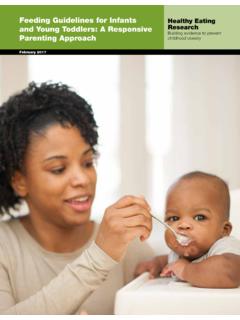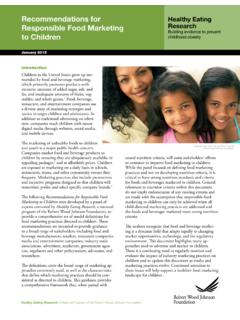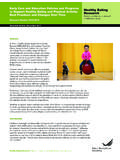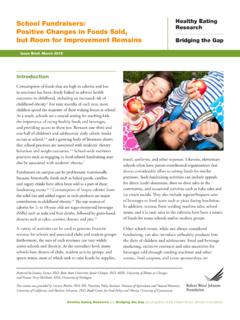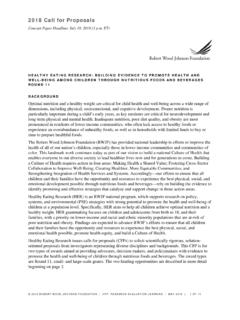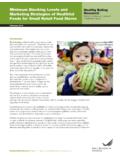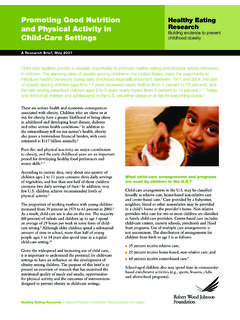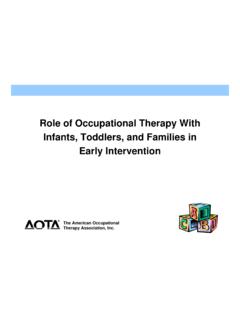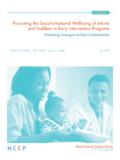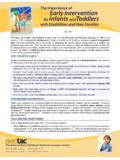Transcription of Feeding Infants and Young Toddlers: Using the Latest ...
1 Feeding Infants and Young Toddlers: Using the Latest evidence in Child-Care SettingsHealthy Eating ResearchBuilding evidence to prevent childhood obesityIssue Brief, May 2017 IntroductionEarly childhood is a critical period in the development, growth, and health of Young children. The most recent data indicate that 60 percent of children ages 0 to 5 in the United States were under non-parental care at child-care centers (41%), home care by a relative (26%), and/or home care by a non-relative (5%). These child-care settings are part of the network of Early Care and Education (ECE) programs. ECE programs include both appropriate caregiving and one or more feedings, making ECE providers key players in the implementation of Feeding and dietary guidelines targeting Infants and life diet and Feeding strategies play an important role in establishing healthy food preferences and behaviors, yet there is a lack of evidence -based guidelines for infant and toddler Feeding practices in the United States.
2 Furthermore, such guidelines are needed to address the prevention of child overweight and obesity, as a significant proportion of children ages 2 or younger are already at risk. While there is strong justification for comprehensive infant and toddler Feeding guidelines, current Dietary Guidelines for Americans (DGA) do not address the age group of birth to 24 months. As new evidence suggests that nutrition within the first 1,000 days (the period from conception to age 2) is critical in a child s growth and development, such recommendations are expected to be included in the 2020 DGA. In 2016, Healthy Eating Research, a national program of the Robert Wood Johnson Foundation, convened an expert panel to review the evidence that has emerged over the past two decades for promoting healthy nutrition and Feeding patterns for Infants and toddlers.
3 The expert panel s full report, Feeding Guidelines for Infants and Young Toddlers: A Responsive Parenting Approach, is available on the Healthy Eating Research issue brief summarizes the evidence presented in the expert panel s full report as it relates to the ECE setting. Healthy Eating Research A National Program of the Robert Wood Johnson Foundation2 Feeding Infants and Young Toddlers: Using the Latest evidence in Child-Care Settings | May 2017A series of detailed guidelines adapted for ECE providers on how and what to feed Infants and toddlers can be found in the appendices attached to this brief. Information that can be distributed to parents can be found within the full report.
4 This issue brief provides guidelines on how and what to feed Infants and toddlers ages 2 or younger, based on current scientific evidence , within the context of the growing child and responsive caregiving. The brief also highlights related behaviors such as physical activity, television and other media use (screen time), and sleep, as well as important considerations including food allergies and food safety for this age group. Recognizing that ECE settings are regulated not only by federal standards, but also by rules and regulations at the state and local levels, the adapted guidelines included in this brief are intended to be general enough for integration into Feeding times in ECE settings across the nation.
5 The EvidenceThere are many factors influencing what Infants and toddlers consume. ECE providers need to be aware of and understand: how Infants and toddlers develop food preferences and the role ECE providers play in influencing those preferences; how Infants and toddlers signal hunger and fullness; and the role of responsive Feeding in developing healthy food habits. Further, ECE providers also need to understand: how and when to feed complementary foods; sleep patterns and their influence on healthy eating; physical activity needs of Infants and toddlers; and the need for limits on screen time. BreastfeedingDue to the health benefits that breastfeeding offers to children and women, the American Academy of Pediatrics (AAP) recommends that Infants be breastfed exclusively from birth until about 6 months.
6 Once complementary foods are introduced, it is recommended that breastfeeding continue until the child is at least 1 year old. Among Infants born in 2013, percent of women in the United States initiated breastfeeding; however, by six months the percent of women engaged in any breastfeeding dropped to percent, and by one year to percent. Differences in breastfeeding rates are observed across income categories, states, and Women returning to work or school can find breastfeeding particularly challenging, as it can be difficult to maintain an adequate milk supply without the proper supports in ECE support of breastfeeding working mothers is essential, as many use ECE programs for their Infants and Young toddlers.
7 Suggested best practices to support breastfeeding in the ECE setting include: encouraging lactating mothers to nurse upon arrival, during visits, and before departure; providing a quiet, private, comfortable place in which mothers can breastfeed; and ensuring breastfeeding mothers and ECE staff practice safe handling and labeling of expressed breast milk. Shaping Food Preferences Among Infants and ToddlersECE providers have the opportunity to play a vital role in shaping the food preferences of Young children in their care. Understanding how flavor and food preferences are established early in life is crucial as early childhood dietary patterns track into later childhood and adolescence.
8 The evidence suggests that Infants born to mothers who consumed fruits and vegetables during pregnancy and while breastfeeding are more likely to learn to accept these of exposure during pregnancy and breastfeeding, repeated exposure to new and different foods is necessary so that Infants and Young children learn to like them, especially for those foods that have bitter or sour tastes, as is the case with many vegetables. Likewise, it is vital to expose Infants to different textures in order to properly transition to table food for example, moving from pureed to mashed to lumpy and to chopped soft solid food during the first two years of life. By age 2, it is expected that children will have fully transitioned to table food.
9 For these reasons, it is crucial for meals in the ECE setting to include a plentiful supply of fruits and vegetables. Furthermore, ECE providers can facilitate repeated exposures of healthy food, including fruits, vegetables, and whole grains, until Infants and toddlers learn to like and accept Role of the Feeding Environment Infants and toddlers rely entirely on their caregivers to learn what, when, and how to eat. ECE providers should decide which types of foods are made available to Infants and toddlers and the amount of food served, the frequency with which food is offered, and the type and size of utensils used to eat (if any). Allowing Infants and toddlers to become familiar with healthy foods, such as vegetables, is key for the development of healthy food preferences.
10 Numerous attempts are needed for most Infants to accept and learn to like new vegetables. The chances of accepting a new food may increase by pairing it with a food or sauce the infant / toddler is already familiar 3 Feeding Infants and Young Toddlers: Using the Latest evidence in Child-Care Settings | May 2017with and likes ( , red bell peppers or yellow squash with a preferred healthy dip). evidence also shows that Young children are more likely to try new and different foods when they observe their caregivers eating them enthusiastically, as opposed to when the food is offered to them without having a role model present. Thus, ECE providers are critically important in modeling healthy eating behaviors by sitting at the table with and eating the same foods as the child.
